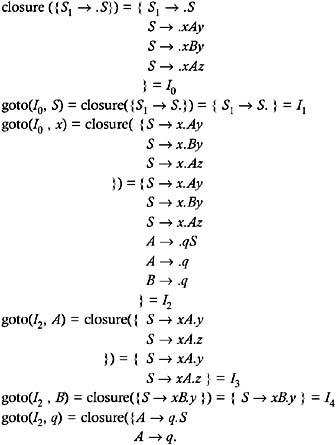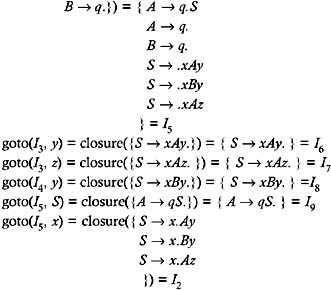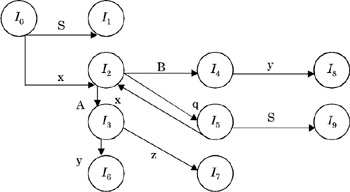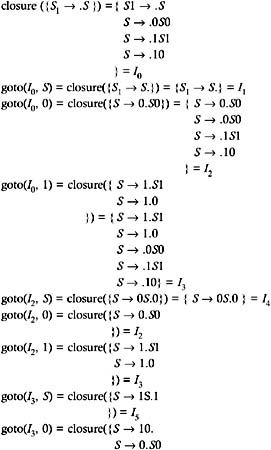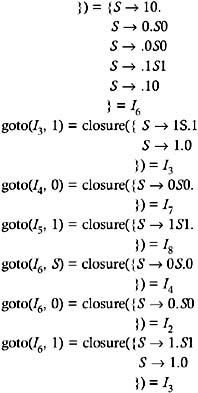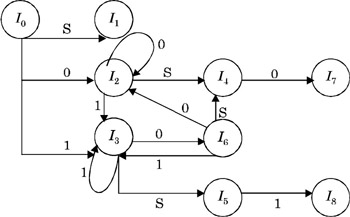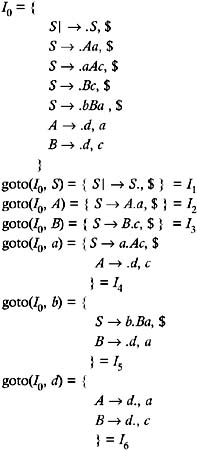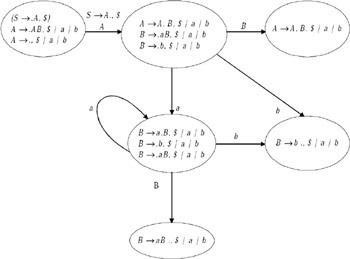The transition diagram of this DFA is shown in Figure 1.
The FOLLOW sets of the various nonterminals are FOLLOW(S1) = {$}. Therefore:
-
Using S1 → S, we get FOLLOW(S) = FOLLOW(S1) = {$}
-
Using S → xAy, we get FOLLOW(A) = {y}
-
Using S → xBy, we get FOLLOW(B) = {y}
-
Using S → xAz, we get FOLLOW(A) = {z}
Therefore, FOLLOW(A) = {y, z}. Using A → qS, we get FOLLOW(S) = FOLLOW(A) = {y, z}. Therefore, FOLLOW(S) = {y, z, $}. Let the productions of the grammar be numbered as follows:
The SLR parsing table for the productions above is shown in Table 1.
|
Action Table |
GOTO Table |
|||||||
|---|---|---|---|---|---|---|---|---|
| � |
x |
Y |
Z |
q |
$ |
S |
A |
B |
|
I0 |
S2 |
R3/R4 |
� | � | � |
1 |
� | � |
|
I1 |
� | � |
Accept |
� | � | � | � | � |
|
I2 |
� | � | � |
S5 |
� | � |
3 |
4 |
|
I3 |
� |
S6 |
S7 |
� | � | � | � | � |
|
I4 |
� |
S8 |
� | � | � | � | � | � |
|
I5 |
S2 |
R5/R6 |
R5 |
� | � |
9 |
� | � |
|
I6 |
� |
R1 |
R1 |
� |
R1 |
� | � | � |
|
I7 |
� |
R3 |
R3 |
� |
R3 |
� | � | � |
|
I8 |
� |
R2 |
R2 |
� |
R2 |
� | � | � |
|
I9 |
� |
R4 |
R4 |
� | � | � | � | � |
The transition diagram of the DFA is shown in Figure 2.
The FOLLOW sets of the various nonterminals are FOLLOW(S1) = {$}. Therefore:
-
Using S1 → S, we get FOLLOW(S) = FOLLOW(S1) = {$}
-
Using S → 0S0, we get FOLLOW(S) = { 0 }
-
Using S → 1S1, we get FOLLOW(S) = {1}
So, FOLLOW(S) = {0, 1, $}. Let the productions be numbered as follows:
The SLR parsing table for the production set above is shown in Table 2.
|
Action Table |
GOTO Table |
|||
|---|---|---|---|---|
| � |
0 |
1 |
$ |
S |
|
I0 |
S2 |
S3 |
� |
1 |
|
I1 |
� | � | � |
accept |
|
I2 |
S2 |
S3 |
� |
4 |
|
I3 |
S6 |
S3 |
� |
5 |
|
I4 |
S7 |
� | � | � |
|
I5 |
� |
S8 |
� | � |
|
I6 |
S2/R3 |
S3/R3 |
R3 |
4 |
|
I7 |
R1 |
R1 |
� |
R1 |
|
I8 |
R2 |
R2 |
� |
R2 |
The augmented grammar is:
The canonical collection of sets of LR(1) items is:
The parsing table for the production above is shown in Table 3.
|
Action Table |
GOTO Table |
|||
|---|---|---|---|---|
| � |
A |
B |
$ |
S |
|
I0 |
S2 |
S3 |
R3 |
1 |
|
I1 |
� | � |
Accept |
� |
|
I2 |
S5 |
S6/R3 |
� |
4 |
|
I3 |
S8/R3 |
S9 |
� |
7 |
|
I4 |
� |
S10 |
� | � |
|
I5 |
S5 |
S6/R3 |
� |
11 |
|
I6 |
S8/R3 |
S9 |
� |
12 |
|
I7 |
S13 |
� | � | � |
|
I8 |
S5 |
S6/R3 |
� |
14 |
|
I9 |
S8/R3 |
S9 |
� |
15 |
|
I10 |
S2 |
S3 |
R3 |
16 |
|
I11 |
� |
S17 |
� | � |
|
I12 |
S18 |
� | � | � |
|
I13 |
S2 |
S3 |
R3 |
19 |
|
I14 |
� |
S20 |
� | � |
|
I15 |
� |
S21 |
� | � |
|
I16 |
� | � |
R1 |
� |
|
I17 |
S5 |
S6/R3 |
� |
22 |
|
I18 |
S5 |
S6/R3 |
� |
23 |
|
I19 |
� | � |
R2 |
� |
|
I20 |
S8/R3 |
S9 |
� |
24 |
|
I21 |
S8/R3 |
S9 |
� |
25 |
|
I22 |
� |
R1 |
� | � |
|
I23 |
� |
R2 |
� | � |
|
I24 |
R1 |
� | � | � |
|
I25 |
R2 |
� | � | � |
The productions for the grammar are numbered as shown below:
Construct an LALR(1) parsing table for the following grammar:
The augmented grammar is:

The canonical collection of sets of LR(1) items is:
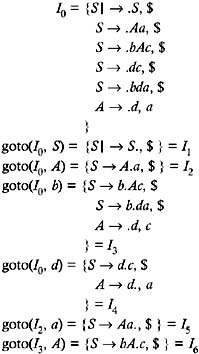
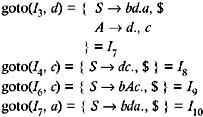
There no sets of LR(1) items in the canonical collection that have identical LR(0)-part items and that differ only in their lookaheads. So, the LALR(1) parsing table for the above grammar is as shown in Table 4.
|
Action Table |
GOTO Table |
||||||
|---|---|---|---|---|---|---|---|
| � |
a |
b |
c |
d |
$ |
S |
A |
|
I0 |
� |
S3 |
� |
S4 |
� |
1 |
2 |
|
I1 |
� | � | � | � |
Accept |
� | � |
|
I2 |
S5 |
� | � | � | � | � | � |
|
I3 |
� | � | � |
S7 |
� |
1 |
� |
|
I4 |
R5 |
� |
S8 |
� | � | � | � |
|
I5 |
� | � | � | � |
R1 |
� | � |
|
I6 |
S10 |
� |
S9 |
� | � | � | � |
|
I7 |
� | � |
R5 |
� | � | � | � |
|
I8 |
� | � | � | � |
R3 |
� | � |
|
I9 |
� | � | � | � |
R2 |
� | � |
|
I10 |
� | � | � | � |
R4 |
� | � |
The productions of the grammar are numbered as shown below:
-
S → Aa
-
S → bAc
-
S → dc
-
S → bda
-
A → d
Since no sets of LR(1) items in the canonical collection have identical LR(0)-part items and differ only in their lookaheads, the LALR(1) parsing table for the above grammar is as shown in Table 5.
|
Action Table |
GOTO Table |
|||||||
|---|---|---|---|---|---|---|---|---|
| � |
a |
b |
c |
d |
$ |
S |
A |
B |
|
I0 |
S4 |
S5 |
� |
S6 |
� |
1 |
2 |
3 |
|
I1 |
� | � | � | � |
Accept |
� | � | � |
|
I2 |
S7 |
� | � | � | � | � | � | � |
|
I3 |
� | � |
S8 |
� | � | � | � | � |
|
I4 |
� | � | � |
S10 |
� | � |
9 |
� |
|
I5 |
� | � | � |
S12 |
� | � | � |
11 |
|
I6 |
R5 |
� |
R6 |
� | � | � | � | � |
|
I7 |
� | � | � | � |
R1 |
� | � | � |
|
I8 |
� | � | � | � |
R3 |
� | � | � |
|
I9 |
� | � |
S13 |
� | � | � | � | � |
|
I10 |
� | � |
R5 |
� | � | � | � | � |
|
I11 |
S14 |
� | � | � | � | � | � | � |
|
I12 |
R6 |
� | � | � | � | � | � | � |
|
I13 |
� | � | � | � |
R2 |
� | � | � |
|
I14 |
� | � | � | � |
R4 |
� | � | � |
The productions of the grammar are numbered as shown below:
-
S → Aa
-
S → aAc
-
S → Bc
-
S → bBa
-
A → d
-
B → d
The collection of nonempty sets of LR(1) items is shown in Figure 3.


